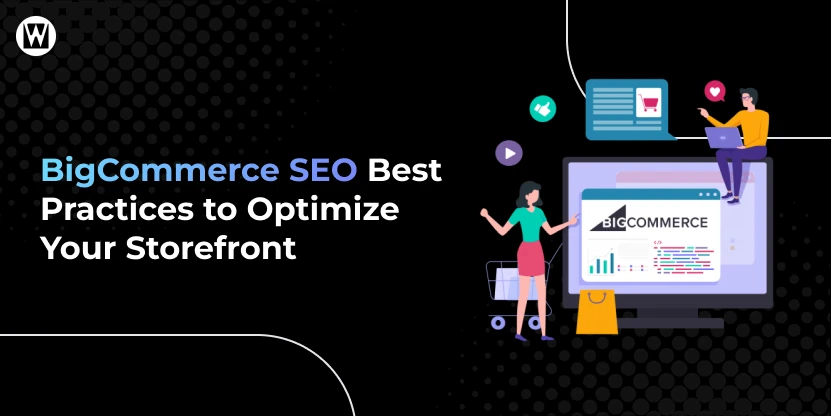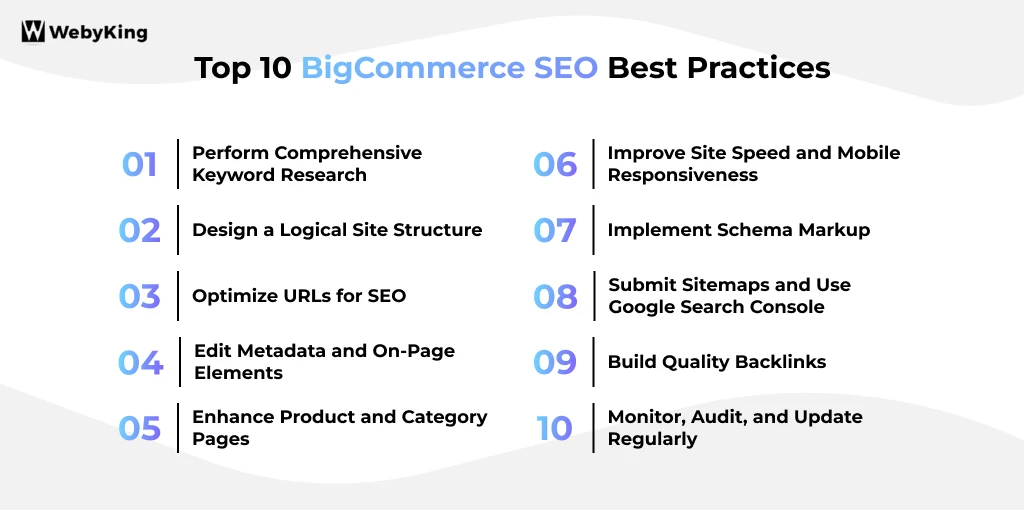BigCommerce SEO Best Practices to Optimize Your Storefront

Getting noticed online is tough, especially for online stores. BigCommerce is a solid platform that helps you sell more. But simply building a store isn’t enough. To attract visitors and turn them into buyers, you need good SEO.
BigCommerce SEO gets your store seen on Google and other search engines. It’s about making changes that boost your visibility, traffic, and sales. Remember, SEO isn’t a one-time task. It needs continuous effort to keep up with new trends and changing algorithms.
In this detailed guide, we will cover everything you need to know about BigCommerce SEO and how to optimize your store for success. But let’s start with the meaning first.
What is BigCommerce SEO?
BigCommerce SEO is like giving your online store a sparkling personality that stands out in the crowded marketplace. It’s the art and science of enhancing your BigCommerce storefront so search engines (like Google) can easily find, understand, and rank your products.
Think of it as throwing on some stylish accessories that not only make you look great but also help you get noticed. From optimizing your content to tweaking your site structure, BigCommerce SEO helps ensure that your store doesn’t just exist in the online realm—it thrives.
Importance of SEO for BigCommerce
When you’re running a BigCommerce store, it’s easy to focus on design, products, and promotions – but none of it matters if your store isn’t showing up in search results.
That’s where SEO quietly becomes one of the most valuable tools in your toolkit. It’s not about quick hacks; it’s about building long-term visibility and trust, both with search engines and real people.
Here’s why SEO truly matters for your BigCommerce store:
- Unlike paid ads that stop the moment your budget runs out, SEO helps bring in qualified visitors day after day, without ongoing spend.
- Good SEO isn’t just for search engines; it naturally leads to faster load times, mobile-friendly layouts, and intuitive navigation, all of which benefit your customers.
That’s why partnering with the right SEO services can make a huge difference. They help you stay ahead of ever-changing algorithms and focus on what matters most—your customers. And while it takes time, the long-term benefits of SEO—from increased traffic to brand authority—are well worth the investment.
SEO isn’t just a marketing tactic; it’s a growth engine for your BigCommerce store.
SEO takes time, strategy, and ongoing effort—especially on a platform like BigCommerce. If you’re unsure where to start or want expert support, our team can help.
BigCommerce SEO Best Practices
Now that we understand the significance of SEO for BigCommerce, let’s dive into some proven practices and strategies to get you started on optimizing your site.
With the correct methodology and tools, you can build a solid SEO foundation for your BigCommerce store. Here are some impactful practices to get the fundamentals right:

1. Perform Comprehensive Keyword Research
Keyword research is the cornerstone of any successful SEO strategy. It involves identifying the words and phrases your potential customers use when searching for products like yours.
How to Do It:
- Use Keyword Tools: Platforms like Google Keyword Planner, SEMrush, Ahrefs, and Ubersuggest can help you discover relevant keywords, their search volumes, and competition levels.
- Analyze Competitors: Look at the keywords your competitors rank for using tools like SEMrush’s Organic Research or Ahrefs’ Site Explorer.
- Focus on Long-Tail Keywords: These are longer, more specific search terms (e.g., “best waterproof hiking boots for women”) that typically have lower competition and higher conversion rates.
- Map Keywords to Pages: Assign primary and secondary keywords to specific product and category pages to avoid keyword cannibalization.
Example: If you sell eco-friendly yoga mats, target keywords like “non-toxic yoga mat,” “eco-friendly yoga mat for hot yoga,” or “best biodegradable yoga mat.”
According to Moz, long-tail keywords account for 70% of all web searches, making them essential for capturing targeted traffic.
2. Design a Logical Site Structure
A clear, logical site structure helps users find products easily and allows search engines to crawl your website efficiently.
How to Do It:
- Hierarchy: Organize your site with a simple hierarchy: Homepage > Categories > Subcategories > Product Pages.
- Breadcrumbs: Implement breadcrumb navigation so users can see their path and easily backtrack.
- Internal Linking: Link between relevant pages (e.g., from category pages to best-selling products) to distribute link equity and improve SEO.
For instance, a sporting goods store might structure its site as:
Home > Sports Equipment > Running > Women’s Running Shoes
Tip: Limit the number of clicks from the homepage to any product page (ideally, no more than three).
3. Optimize URLs for SEO
SEO-friendly URLs are short, descriptive, and include relevant keywords.

Source: BigCommerce
How to Do It:
- Keep URLs Simple: Avoid unnecessary parameters, numbers, or special characters.
- Use Hyphens: Separate words with hyphens (e.g., /mens-trail-running-shoes).
Include Keywords: Incorporate target keywords naturally, but don’t overdo it.
❌ Instead of /store/item?id=12345
✅ /yoga-mats/eco-friendly-non-slip
Why It Matters: Clean URLs are easier for users to read and remember and help search engines understand page content.
4. Edit Metadata and On-Page Elements
Metadata and on-page elements tell search engines and users what your pages are about.

How to Do It:
- Title Tags: Write unique, keyword-rich titles for every page (under 60 characters).
- Meta Descriptions: Summarize the page content in 160 characters or fewer, including a call to action.
- Header Tags (H1, H2, H3): Use headers to structure your content and include relevant keywords.
- Alt Text: Describe images with alt text for SEO and accessibility.
Example:
- Title: “Eco-Friendly Yoga Mats | Non-Toxic & Biodegradable”
- Meta Description: “Shop eco-friendly yoga mats made from non-toxic materials. Perfect for hot yoga and the environment. Free shipping on all orders!”
Tip: Use dynamic variables in BigCommerce to automate unique metadata for product pages.
5. Enhance Product and Category Pages
High-quality product and category pages improve user experience and search rankings.
How to Do It:
- Unique Product Descriptions: Avoid copying manufacturer descriptions; write original, persuasive copy highlighting benefits and features.
- High-Quality Images: Use multiple images per product and optimize file sizes for faster loading.
- Customer Reviews: Enable and encourage reviews to build trust and add fresh content.
- Category Descriptions: Add keyword-rich descriptions to category pages to help search engines understand their purpose.
Example:
A category page for “Vegan Leather Handbags” could include a brief intro about vegan materials, top-selling products, and links to related accessories.
According to a BrightLocal survey, 87% of consumers read online reviews for local businesses, making reviews essential for both SEO and trust.
6. Improve Site Speed and Mobile Responsiveness
Fast, mobile-friendly sites rank higher and provide a better user experience.
How to Do It:
- Compress Images: Use tools like TinyPNG to reduce image file sizes.
- Minimize Code: Remove unnecessary JavaScript and CSS.
- Leverage Caching: Enable browser caching to speed up repeat visits.
- Responsive Design: Use a mobile-friendly BigCommerce theme and test your site on various devices.
Example: A site that loads in under 2 seconds will retain more visitors and rank better in Google’s mobile-first index.
According to Google, 53% of mobile users abandon sites that take longer than 3 seconds to load.
7. Implement Schema Markup
Schema markup helps search engines understand your content and can enhance your listings with rich snippets.
How to Do It:
- Product Schema: Add structured data for products, including name, price, availability, and reviews.
- Breadcrumb Schema: Implement to display breadcrumb navigation in search results.
- How-To and FAQ Schema: Use on relevant pages to appear in featured snippets.
For instance, a product page with schema markup may display star ratings, price, and stock status directly in Google search results.
Tip: Use Google’s Rich Results Test tool to validate your schema implementation.
8. Submit Sitemaps and Use Google Search Console
Sitemaps and Google Search Console are essential for getting your pages indexed and monitoring site health.
How to Do It:
- Generate XML Sitemap: BigCommerce automatically creates a sitemap; submit it to Google Search Console.
- Monitor Indexing: Check which pages are indexed and fix any coverage issues.
- Address Errors: Resolve crawl errors, broken links, or duplicate content flagged by Search Console.
Example: If Search Console reports that certain product pages aren’t indexed, investigate for issues like “noindex” tags or poor internal linking.
9. Build Quality Backlinks
Backlinks from reputable sites signal authority to search engines and can boost your rankings.
How to Do It:
- Content Marketing: Create shareable blog posts, guides, or infographics.
- Guest Posting: Write articles for industry blogs and include links back to your store.
- Influencer Outreach: Partner with influencers for product reviews and mentions.
- Local Listings: Ensure your business is listed in relevant directories.
Example: A blog post on “The Benefits of Eco-Friendly Yoga Mats” could attract backlinks from wellness blogs and environmental sites.
According to Ahrefs, 91% of all pages never get any organic traffic from Google, largely due to a lack of backlinks.
10. Monitor, Audit, and Update Regularly
SEO is ongoing. Regular monitoring and updates keep your store competitive.
How to Do It:
- Track Performance: Use Google Analytics and Search Console to monitor traffic, rankings, and conversions.
- SEO Audits: Periodically audit your site for broken links, duplicate content, and technical issues.
- Content Updates: Refresh outdated content, add new products, and update keywords as trends change.
- Competitor Analysis: Keep an eye on competitors’ SEO strategies and adapt as needed.
Example: If a product page’s ranking drops, review its content, check for new competitors, and update keywords or add new images.
By following and continually refining these BigCommerce SEO best practices, you’ll set your store up for long-term organic growth, better user experiences, and higher sales. If you need tailored recommendations for your specific store, let me know!
Additional Tips to Accelerate Your BigCommerce Store
After covering the essential and widely recommended BigCommerce SEO and optimization practices, it’s time to dive into some advanced technical strategies. The following additional tips will help you achieve even greater performance, visibility, and scalability for your BigCommerce store.
Implement Rich Snippets with Structured Data
- Enhance your search listings by adding structured data (Schema.org) to your product pages.
- Rich snippets display extra information such as ratings, price, and availability directly in search results, making your listings more attractive and improving click-through rates.
For example, adding a review schema can show star ratings next to your products in Google search, helping you stand out from competitors.
Leverage a Content Delivery Network (CDN)
- A CDN distributes your store’s static assets – like images, CSS, and JavaScript – across global servers, ensuring faster loading times for customers regardless of their location.
- Using BigCommerce built-in CDN can boost site speed by up to 50%, reduce latency, and provide a smoother shopping experience, especially during high-traffic periods.
Optimize and Minify Code
- Reduce load times by minifying your CSS, JavaScript, and HTML files—removing unnecessary spaces, comments, and characters.
- Combining files and loading non-essential scripts asynchronously can decrease page load times by up to 35%, ensuring your site remains responsive as your catalog and traffic grow.
Streamline Third-Party Apps and Integrations
- While apps add valuable features, too many can slow down your store.
- Regularly audit your installed apps, removing those you no longer use, and choose lightweight solutions whenever possible.
Each additional app adds code and potential load time, so keep your stack lean for optimal performance.
Automate Image Optimization
- Set up workflows to automatically compress and resize images upon upload. Use modern file formats like WebP for smaller file sizes without losing quality.
- This ensures your growing product catalog doesn’t bog down your site speed and keeps your visual content sharp and fast-loading.
Adopting these additional technical enhancements will help you scale effectively, deliver a super user experience, and gain a competitive edge in the crowded eCommerce landscape.
Conclusion
Optimizing your BigCommerce store for search engines is critical in today’s competitive digital world. Implementing the tactics mentioned in this guide will raise your store’s visibility, drive high-quality visitors, and, ultimately, improve its profitability.
Remember to consistently evaluate and alter your SEO efforts based on data-driven insights, as search engine algorithms are constantly changing. With a well-executed SEO plan, your BigCommerce store may realize its full potential and prosper in the online economy. So, apply these ideas to elevate your SEO game and generate success for your BigCommerce store.
Looking for a digital marketing agency? Contact WebyKing’s experts to learn how our BigCommerce SEO and BigCommerce Development services can help you improve rankings, performance, and long-term growth.
If you’re serious about driving organic traffic, ranking your products, and getting more sales—let’s talk. We specialize in SEO for BigCommerce and can build a strategy tailored to your store.
FAQs About BigCommerce SEO Practices
Is BigCommerce good for SEO?
Yes, BigCommerce is considered SEO-friendly, offering features like customizable URLs, meta tags, mobile-responsive templates, and built-in HTTPS, all of which help improve your store’s search engine rankings.
How do I optimize my BigCommerce product pages for SEO?
To optimize product pages, use unique and keyword-rich titles and descriptions, add high-quality images with descriptive alt text, and ensure URLs and meta tags are relevant. Including customer reviews and detailed product information can further boost SEO performance.
What are the best tools for BigCommerce SEO?
Popular tools include SEO.AI for content and keyword research, as well as Google Search Console and SEMrush for monitoring rankings and site health. BigCommerce also integrates with various SEO apps to automate and streamline optimization tasks.
How can I improve my BigCommerce site speed for better SEO?
Enhance site speed by compressing images, enabling a content delivery network (CDN), minimizing HTTP requests, and leveraging browser caching. Faster load times lead to better user experience and higher search rankings.
What are the common SEO mistakes to avoid on BigCommerce?
Avoid duplicate content, neglecting mobile optimization, ignoring meta tags and descriptions, and using low-quality backlinks. Regular SEO audits can help identify and fix these issues.
How can I track and measure my BigCommerce SEO performance?
Use Google Analytics and Google Search Console to monitor website traffic, keyword rankings, and click-through rates. These tools provide insights to refine your SEO strategy and measure ongoing performance.

Ravi Makhija, the visionary Founder and CEO of WebyKing, is a seasoned digital marketing strategist and web technology expert with over a decade of experience. Under his leadership, WebyKing has evolved into a premier full service web and marketing agency, delivering innovative solutions that drive online success. Ravi’s deep understanding of the digital landscape combined with his passion for cutting-edge technologies empowers him to consistently exceed client expectations and deliver results that matter.













